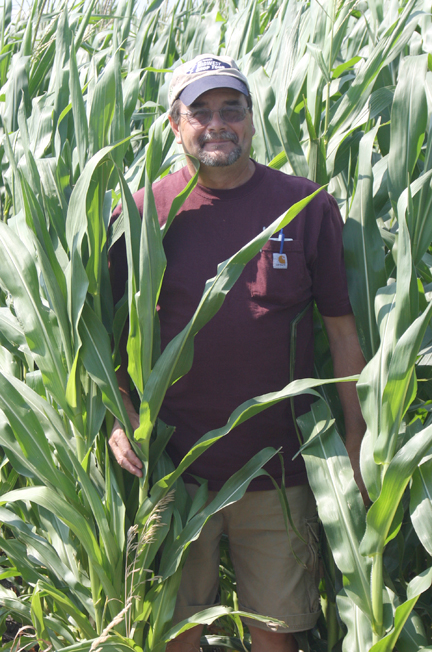Crops looking good at this point

TASSEL TIME — Local agronomist Mark Bernard has high hopes for the 2012 harvest. (Star Eagle photo by Rachel Rietsema)
By RACHEL RIETSEMA
Staff Writer
Like humans, crops of all kinds need their “beauty sleep.”
And, now that we are in the heart of summer, local agronomist Mark Bernard has chosen to divulge a few of the imperative conditions the local fields need to survive and even thrive.
“When overnight temperatures fail to drop into the 60s and dew points remain high, the plants expend more energy to maintain themselves,” Bernard said. “If it continues to happen for extended periods of time, weeks in a row especially with corn, the yield can be compromised as a result of the energy diverted from grain fill.”
Bernard also says that beastly hot temperatures may also cause weaker, more disease-prone corn stalks.
“Warm nights also have a tendency to promote mobilization of sugars from the stalk to the kernels, a cannibalization if you will,” Bernard said. “On some of the later planted corn, one could also potentially see some issues if moisture stress became a factor.”
A lack of moisture will lead to delays in silking and a premature shedding of pollen. He also notes that if the stalks remain thirsty and heat stressed, the silks can emerge but dry out too fast to receive pollen.
“This can happen at temperatures above 95 degrees, but seldom occurs as peak pollen shed is from 9 to 11 a.m.,” Bernard said. “Soybeans take the heat well to a point, but as we’ve seen too often, high temps and little rain the first part of August leads to a mediocre soybean crop due to small bean size and beans per pod.”
For the most part though, the local area isn’t suffering from the rain shortage. Well, not yet anyway.
“In the case of corn, the dryness has been a positive,” Bernard said. “Corn needs to run through some stretches of drier weather to allow the root systems to grow downward rather than more laterally as they tend to do if soils remain wet all the time.”
Drier weather also has perks when it comes to disease pressure, because as he and farmers have noticed, the root and leaf diseases are not as prevalent this year.
“We do need rainfall for both crops in measured amounts,” Bernard said. “We’d like to see rainfall once the corn crop tassels somewhere in the neighborhood of an inch per week as the crop starts to use about 1/3 of an inch per day.”
Actually, Bernard says that with our “pretty good stored soil moisture,” that supplemented rainfall could mean a bountiful harvest.
“We could pull off some pretty fantastic things with the right conditions,” Bernard said. “We’re not there yet though so best not count your chickens before they hatch.”
The three main components needed for success are abundant rains, moderate temperatures and a close eye for potential insect and disease issues.
“Most of us are doing O.K. right now, it’s the heat that should concern us more,” Bernard said. “At this point, we have to be cautiously optimistic. We still have decent soil moisture and the crop is advanced in development for the calendar date.”
Bernard scratches his head trying to determine whether an early April planting is a good or a bad thing. In any case, he is amazed at this year’s results, seeing as it is one risky bet.
“Long-term data indicates no yield advantage to an early plant,” Bernard said. “And two years ago, corn planted on April 8th wound up having reduced stands as a result,” Bernard said. “This time around, it turned out O.K., but for those who think planting the first week in April is now the norm, well, we don’t live in Southern Illinois. That might not be so swell the next time.”
Even just driving by fields, he can see some corn beginning to tassel. This is quite a monumental feat that is not to be taken for granted, he says.
“With all the challenges we’ve faced, one has to be pleased looking out across the fields right now,” Bernard said. “We’ve had tremendous mineralization of nitrogen from the organic matter which is a big plus for the corn, especially when there were concerns we had lost some when applying last fall and some of the heavy rains this spring had moved it down in the soil profile too far.”
Small grains and alfalfa look good from the road too, but don’t let that deceive you. A closer inspection may reveal a host of issues.
“Some of the fungicide treatments were tough to get on and there are some reports of varying types of rust across the state,” Bernard said. “There’s also the potential for bacterial stripe against which fungicides are not effective.”
Some small grains fields are doing quite well, while most alfalfa first cuttings left farmers disappointed. This is due to the dry fall, followed by a warm early spring and then several occurrences of frost in April.
“Those factors doth not a good first cutting hay crop make,” Bernard said. “Hay supplies are tight right now and will get even tighter if some of the ensuing cuttings don’t improve. Rainfall is the key.”
Crops across the board have been introduced to several insects typically not seen in this area. Moths and army cutworms call the Rocky Mountains home, not the Midwest, he adds.
“They do no damage to crops,” Bernard said. “We also saw lots of smaller moths, primarily sod webworms, also a non-factor in crops.”
Only time will tell what the 2012 harvest will be.
“If I knew the end results, I would be on my own private yacht in the harbor of my private island,” Bernard said.
